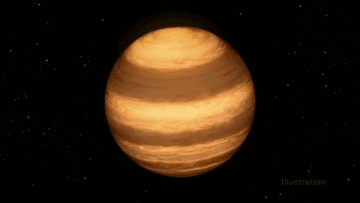This Jupiter-sized star has a giant storm that’s been raging for years

Turns out having “stellar” weather can be pretty unpleasant. Scientists using NASA’s Kepler and Spitzer space telescopes have discovered a long-lived storm on a cool dwarf star that’s reminiscent of Jupiter’s Great Red Spot.
The findings, appearing in the Astrophysical Journal, shed light on the mysterious atmospheric dynamics on these strange objects living on the edge of the blurry boundary between planet and star.
This small, Jupiter-sized star, called WISEP J190648.47+401106 (or W1906+40 for short) is an L-dwarf — one of a cooler class of objects that somewhat awkwardly straddle the line between small star and giant planet. Some L-dwarfs, known as brown dwarfs, are called “failed stars” because they never managed to get nuclear fusion going in their cores. Others, such as W1906+40, make the stellar cut because they managed to stoke their inner furnaces, allowing them to shine.
See the most-read stories in Science this hour >>
And yet, W1906+40 still managed to be cool enough — a mere 3,500 degrees Fahrenheit or so — for clouds to form in its atmosphere and for a giant storm to brew.
This star was first spotted by NASA’s Wide-field Infrared Survey Explorer (or WISE) in 2011; study leader John Gizis of the University of Delaware, Newark and colleagues then looked through NASA’s Kepler data to further examine the star. (It just so happened that Kepler was pointing in the right direction to spot the L-dwarf.)
Kepler finds planets passing in front of their stars by looking for dips in starlight, but it can also pick up star spots — dark patches that rotate around the star’s surface. At first, the scientists wondered if star spots could be the explanation. But using NASA’s Spitzer space telescope, which could use two different wavelengths of infrared light to look at different layers of the star’s atmosphere, the researchers realized that it was not a star spot but an enormous storm that was as wide as three Earths across. This storm sits close to the stellar north pole and completes a trip around the stellar surface roughly every nine hours.
This stormy spot is pretty unusual compared to others in similar stellar objects, the study authors pointed out. Many brown dwarfs seem to have variations on a night-to-night basis that suggests “rapid cloud evolution,” they said.
“The long life of the cloud is in contrast with weather changes seen in cooler brown dwarfs on the timescale of hours and days,” they wrote.
In fact, the researchers believe the storm has been going strong for at least two years — a stability they seemed to find slightly baffling.
“Evidently the W1906+40 spot is very long-lived compared to the ‘weather’ features in cooler L and T dwarfs,” they wrote. “Why would the clouds in W1906+40 be stable?”
Answering that question may take a lot more observation of these kinds of weather patterns on similar stars — something that’s tough to do for ultracool dwarfs with a nine-hour period if you’re using a ground telescope. But Kepler’s second act, the K2 mission, is actually looking at a lot more dwarfs (late-M and L-class dwarfs) in its roughly 75-day campaigns — and so perhaps some fresh insight is soon to come.
“This will allow clouds and weather to be measured through the M/L transition and determine whether the stability of W1906+40’s clouds is typical or unusual,” the authors wrote.
Follow @aminawrite on Twitter for more science news.
MORE FROM SCIENCE
Abortion falls to record low in the U.S., CDC says
Humans take note: Artificial intelligence just got a lot smarter
Geminid meteor shower this weekend: Here’s how to see the show







